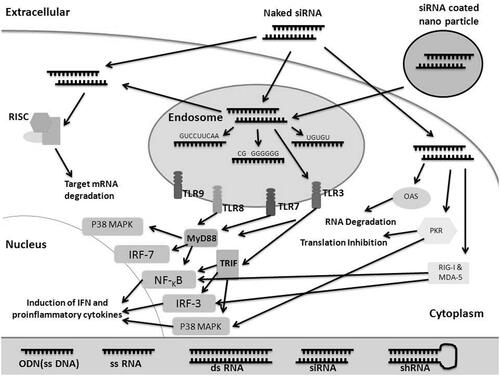Figures & data
Figure 1. Pathways activated in the distinction of siRNAs by the mammalian immune system and mammalian cells. siRNA are distinguished by cells of the mammalian immune system and mammalian cells, through extracellular receptors that include TLR3, TLR7 and TLR8 and cytoplasmic receptors such as PKR, OAS, RIG-I, and MDA-5. In endosomal responses, the ligand-binding domain receptors distinguish the siRNAs before they enter into the cytoplasm. This distinction needs time-dependent endosomal maturation to induce downstream signaling through cytoplasmically located Toll-interleukin-1 receptor (TIR)-domains inducing the MAPK, IRF, and NF-κB pathways leading to the expression of pro-inflammatory cytokines and IFN. The cytoplasmic pathways induce MAPK, IRF-3, and NF-κB pathways leading to the expression of pro-inflammatory cytokines and IFN. Activation of PKR and OAS pathways cause in general protein synthesis inhibition. The key shows the size, base compound, functional and structural varieties between oligodeoxynucleotides (ODNs), double-stranded RNA (ds-RNA), small interfering RNAs (siRNAs), and short hairpin RNAs (shRNAs). IFN, interferon; RISC, RNA-induced silencing complex; IRF, interferon regulatory factor; TLR, toll-like receptor; TIR, Toll-interleukin-1 receptor domain; TRIF, TIR-containing adapter inducing IFN-β; PKR, ds-RNA-dependent protein kinase; RIG-I, retinoic acid-inducible protein; MDA-5, melanoma differentiation-associated protein 5; OAS, 2′5′-oligoadenylate synthetase.

Table I. Pattern recognition receptors (PRRs) distinguish uniquely response to RNA (Bridge et al. Citation2003, Diebold et al. Citation2004, García-Sastre and Biron Citation2006, Hornung et al. Citation2006, Kato et al. Citation2006, Li et al. Citation2006, Schlee et al. Citation2006, Verthelyi and Zeuner Citation2003).
